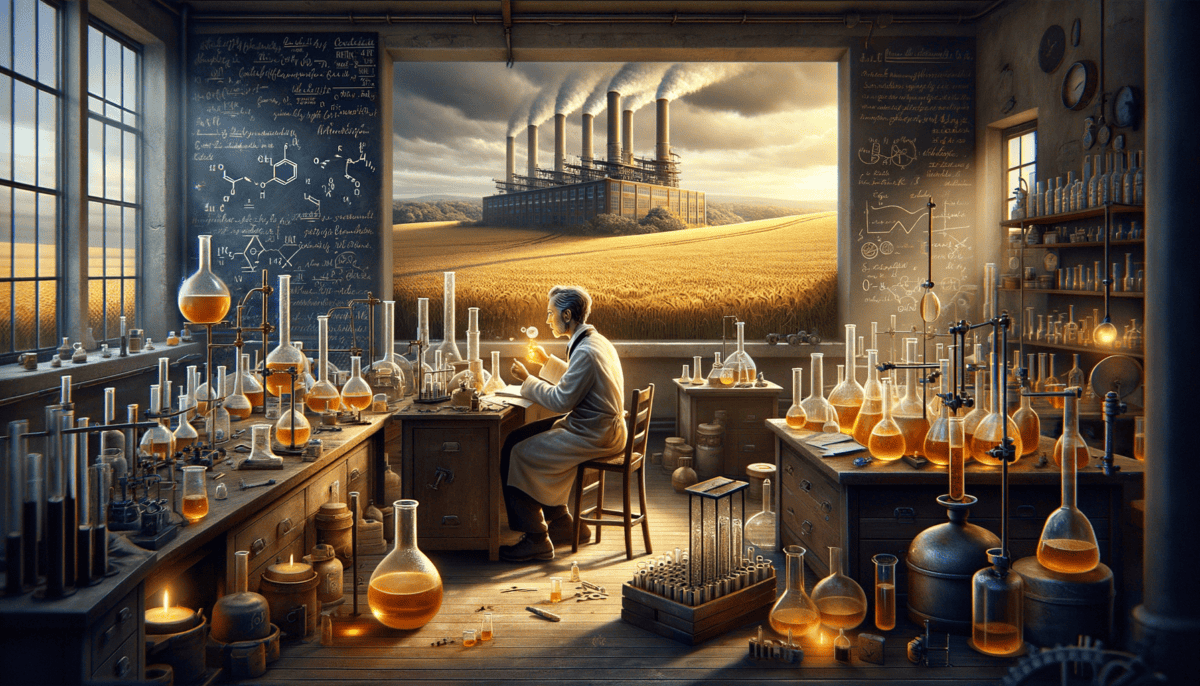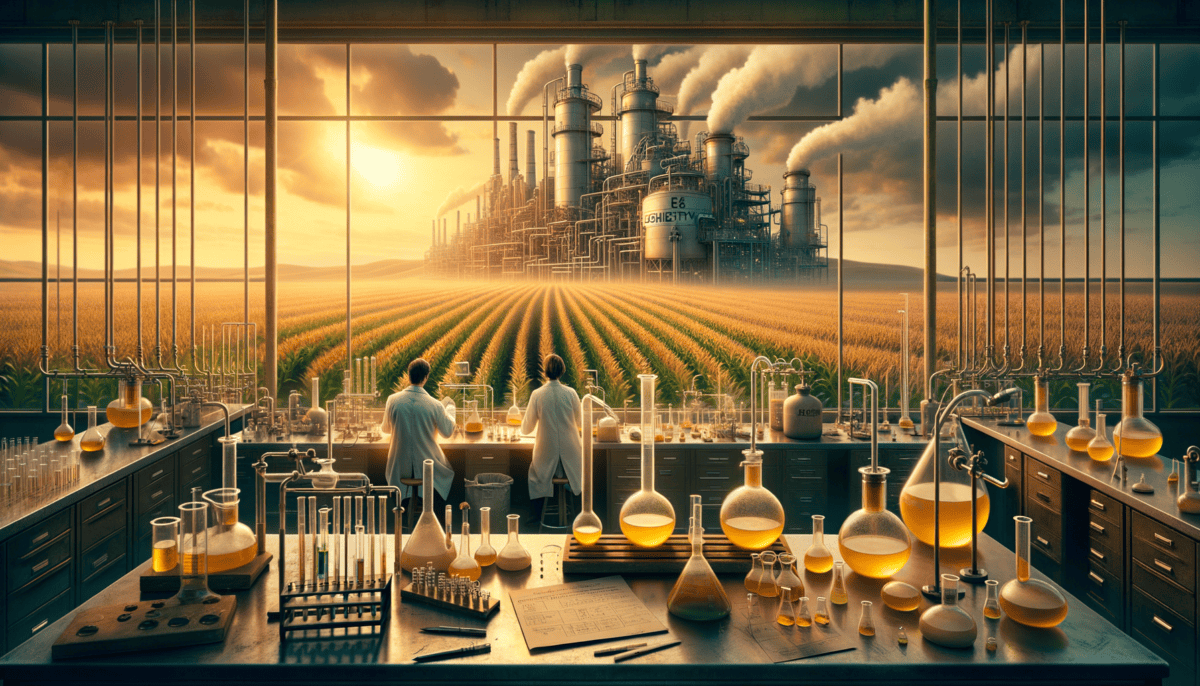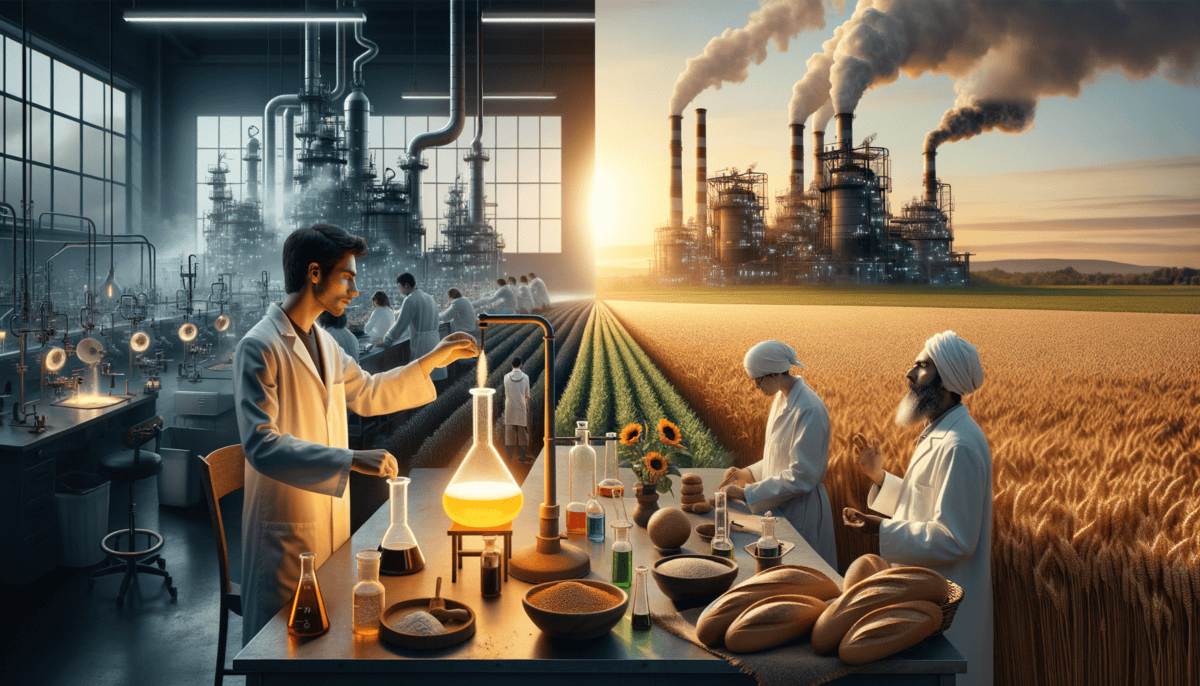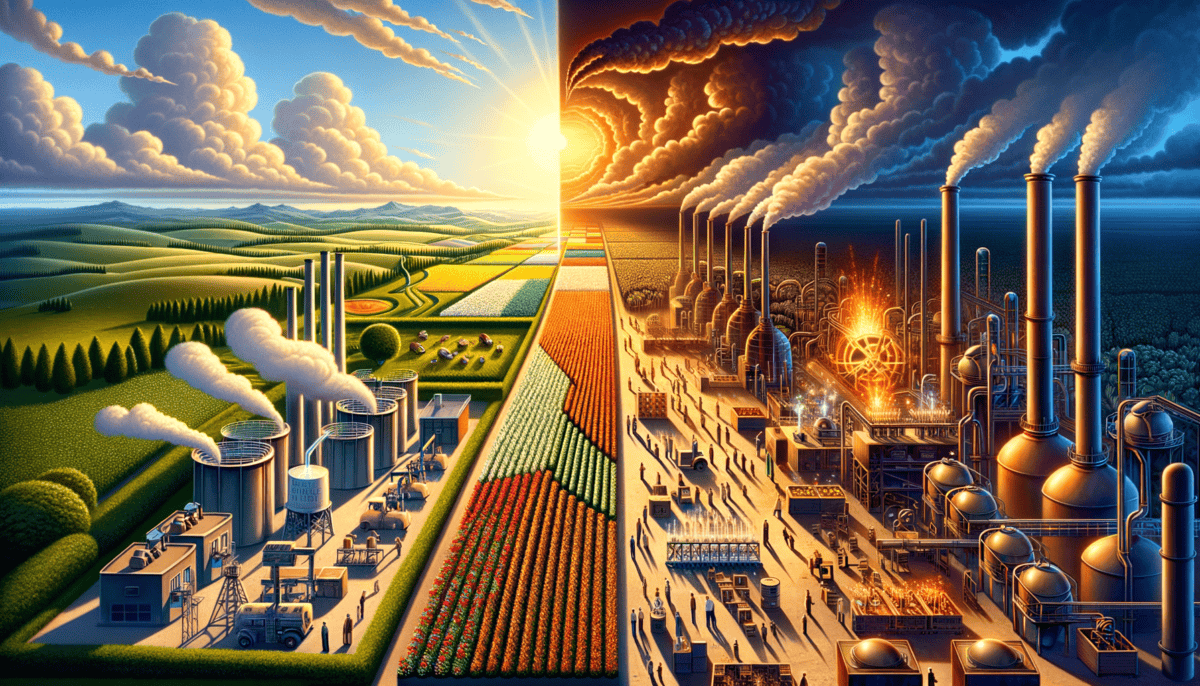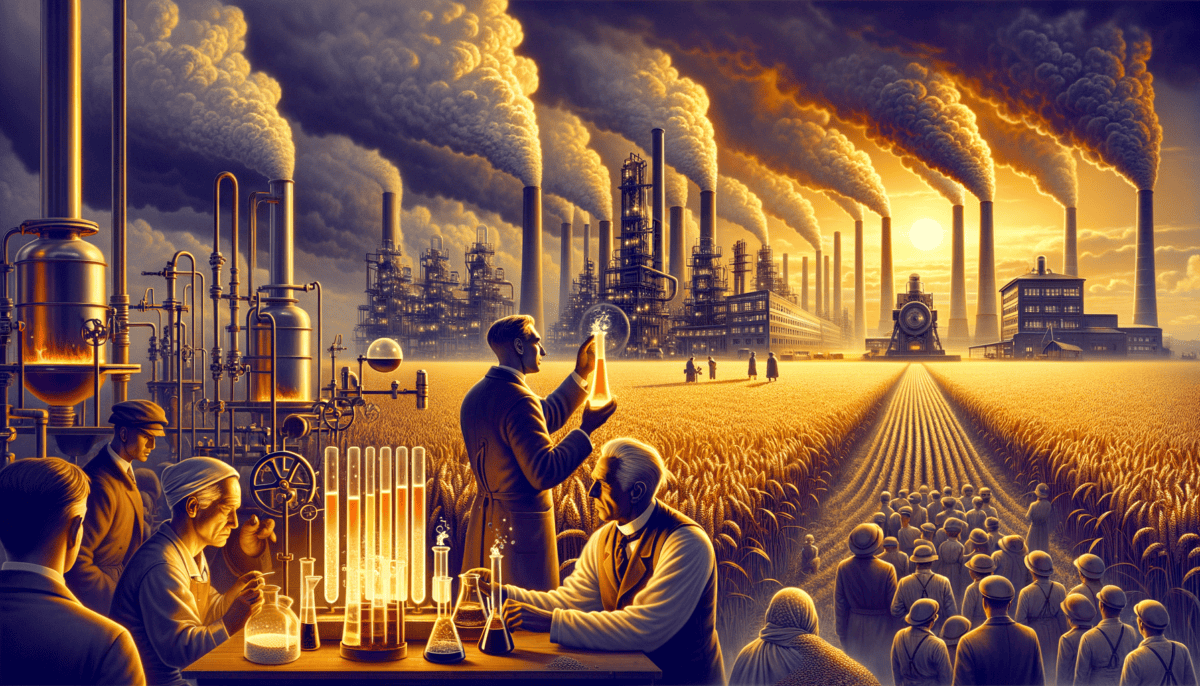The World Was Hungry
A young boy named Fritz Haber sat at his window, watching farmers work in their fields. It was 1898, and the world had a big problem. There wasn't enough food to feed everyone.
"Papa, why do the crops look so small?" Fritz asked his father.
"The soil is tired, my son," his father replied. "It doesn't have enough food to make plants grow big and strong anymore."
Fritz pressed his nose against the glass, his bright eyes full of curiosity. He watched as farmers spread manure on their fields, hoping to make their crops grow better. But it wasn't working well enough.
Fritz grew up to become a scientist. He worked in a special room called a laboratory, where he mixed different things together to see what would happen. One day, he made an amazing discovery.
"Look at all the air around us," he said to his assistant. "The air is full of nitrogen. Plants need nitrogen to grow. What if we could grab it from the air and give it to the plants?"
His eyes sparkled with excitement as he wrote in his notebook:
- Plants need nitrogen to grow big and strong
- Air is mostly made of nitrogen
- If we can catch nitrogen from air, we can feed more people
But catching nitrogen from the air wasn't easy. It was like trying to catch a cloud – it kept slipping away!
"Everyone says it's impossible," Fritz told his wife Clara one evening. "But I won't give up. Too many people are hungry."
Fritz worked day and night in his laboratory. He mixed gases together. He heated them up. He cooled them down. Sometimes things went wrong – BOOM! But he kept trying.
"The nitrogen and hydrogen just won't stick together," he muttered to himself. "There must be a way…"
People started calling Fritz crazy. They said he was wasting his time. But Fritz remembered the hungry farmers and their small crops. He knew he had to keep trying.
“Nature guards her secrets well,” Fritz wrote in his diary. “But science is patient. We will find a way to turn air into bread.”
One stormy night, while everyone else was sleeping, Fritz made a breakthrough. He found that using very high pressure and the right temperature could make nitrogen and hydrogen stick together! This would help make something called ammonia, which could feed plants and help them grow.
"Clara! Clara!" he shouted, waking up his wife. "I think I've done it! We can make food from air!"
His wife rubbed her eyes and smiled. She had always believed in him, even when others didn't.
The next morning, Fritz rushed to his laboratory. His hands shook with excitement as he set up his equipment. This was just the beginning of something that would change the world forever.
Fritz looked out his laboratory window at the fields beyond. Soon, those small, weak crops would grow tall and strong. Soon, there would be enough food for everyone.
But first, he had to prove his discovery would work. And that would be his biggest challenge yet…
The Race Against Time
Fritz walked into his laboratory early one morning, his mind buzzing with ideas. The sunlight streaming through the windows made the glass tubes sparkle.
“Today is the day,” he said to himself, pulling on his white coat. “We must make the nitrogen and hydrogen dance together!”
His assistant Robert came running in, nearly knocking over a stack of papers. “Professor Haber! A letter came for you!”
Fritz opened the letter with shaky hands. It was from Carl Bosch, a famous engineer. Carl wanted to help make Fritz’s idea bigger!
“Dear Professor Haber,” Fritz read aloud, “Your work with nitrogen is very interesting. May I visit your laboratory?”
Fritz jumped up and down with excitement! But then he looked at his messy experiments. Nothing was working right.
“Robert,” Fritz called out, “we need to try something new. Bring me the pressure gauge!”
They tried different things:
- Higher temperatures
- More pressure
- Different metal helpers called catalysts
BOOM! Another experiment failed. Black smoke filled the room.
“Don’t worry,” Robert coughed, waving away the smoke. “We’ll try again!”
“Science is like cooking,” Fritz told Robert. “Sometimes you have to try many recipes before you find the right one.”
One day, a tall man with a big mustache walked into the laboratory. It was Carl Bosch!
“Show me what you’ve done so far,” Carl said kindly.
Fritz’s hands trembled as he showed Carl his experiments. “The nitrogen and hydrogen still won’t stick together properly,” he admitted.
Carl stroked his mustache thoughtfully. “What if we try something different? What if we squeeze them together really, really hard?”
Fritz’s eyes lit up. “Yes! And we need to find the perfect metal helper too!”
Carl and Fritz worked together day after day. They tried iron, they tried platinum, they tried all sorts of metals.
“Look!” Robert shouted one afternoon. “The gases… they’re combining!”
A tiny amount of ammonia had formed in their tube. It wasn’t much, but it was a start!
“We did it!” Fritz hugged Carl. “Now we just need to make more!”
But making more wouldn’t be easy. They needed bigger machines, stronger pipes, and lots more help.
“Don’t worry,” Carl said with a smile. “I know how to build big machines. Together, we’ll feed the world!”
That night, Fritz wrote in his notebook: “Today, we made bread from air. Tomorrow, we make enough for everyone.”
The real work was just beginning. Fritz and Carl had found the recipe, but now they needed to cook for the whole world…
The Magic Mix
The morning sun peeked through the laboratory windows as Fritz stared at his latest experiment. His heart was racing with excitement!
“The pressure must be perfect,” Fritz whispered, turning a big metal wheel. Beside him, Robert watched the gauges carefully.
“Like squeezing a giant balloon into a tiny box,” Robert said, his eyes wide with wonder.
The machine hummed and shook. Inside, nitrogen from the air and hydrogen were being squeezed together harder than ever before!
Carl Bosch walked in, carrying a small metal box. “I brought something special,” he smiled. “A new metal helper – iron with tiny bits of other metals mixed in!”
“What’s so special about this metal?” Robert asked, peering at the shiny powder.
Fritz’s eyes sparkled. “It’s like a magical dance partner! It helps the nitrogen and hydrogen dance together better!”
They carefully put the new metal helper into the machine. The pressure gauge climbed higher and higher:
- 100 elephants of pressure… nothing happened
- 150 elephants of pressure… still waiting
- 200 elephants of pressure… and then…
HISSSS! A new sound filled the room!
“Look!” Robert jumped up and down. “The collection tube is filling up!”
Fritz couldn’t believe his eyes. After so many tries, they had finally done it! The ammonia they made could help plants grow big and strong.
“But will it be enough?” Carl wondered, stroking his mustache. “Can we make more?”
Fritz paced around the room, thinking hard. “We need bigger machines,” he said. “Much bigger!”
Robert scratched his head. “How will we build them? Won’t they explode under all that pressure?”
Carl pulled out his notebook. “Leave that to me,” he said with a smile. “I know just how to make them strong enough!”
That night, Fritz couldn’t sleep. He kept thinking about all the hungry people who could now have food.
“Today we made a drop,” he wrote in his journal. “Tomorrow we’ll make an ocean!”
The next morning, newspapers arrived with exciting news: Scientists all over were talking about Fritz’s discovery! But some people didn’t believe it would work.
“We’ll show them,” Fritz said, rolling up his sleeves. “Carl, we need to build the biggest machine ever!”
Carl nodded, already drawing plans. “It will be as tall as a house,” he said. “And strong enough to hold back an army of elephants!”
Robert looked worried. “What if it doesn’t work?”
Fritz put his hand on Robert’s shoulder. “In science, we never give up. We just find new ways to try!”
The sun set on their busy laboratory, but the real adventure was just beginning. They had found the magic recipe – now they needed to cook for the whole world!
Building Dreams
Carl Bosch stood in front of a huge metal tank. It was as tall as a house! His hands felt sweaty as he looked at his creation.
“Will it really work?” asked one of the workers. They all looked nervous.
“We’ve built it stronger than any tank before,” Carl said with a smile. “This tank can handle the pressure of 300 elephants!”
The factory floor buzzed with excitement. Workers scurried around like busy ants, checking pipes and tightening bolts.
Fritz walked in, his eyes wide at the sight. “It’s… it’s beautiful!” he gasped.
“But will it be safe?” asked Maria, one of the safety checkers. She tapped the thick metal walls.
Carl showed them his special design:
- Double-thick walls to keep the pressure in
- Special cooling pipes to control the heat
- Safety valves that let out extra pressure
- Strong metal that won’t crack or break
“Watch this!” Carl said excitedly. He turned a big wheel, and the machine started to hum.
But then… CLANK! A loud noise made everyone jump!
“Stop the machine!” shouted Maria.
Carl rushed to check what was wrong. He found a small crack in one of the pipes.
“Don’t worry,” he said, wiping his forehead. “This is why we test. We’ll make it stronger!”
Day after day, they fixed problems and tried again:
Monday: The pressure was too high
Tuesday: The metal got too hot
Wednesday: The pipes leaked
Thursday: The catalyst didn’t work right
But Carl never gave up. He kept making things better.
“Each problem we fix is one step closer to success,” he told his tired team.
Finally, after many tries, the big day came. The giant machine was ready!
“Everyone ready?” Carl called out. The workers nodded.
He turned the wheel slowly. The machine hummed to life. This time, there were no scary noises!
“Look!” Fritz pointed to the collection tank. “It’s working! We’re making ammonia!”
Everyone cheered! The first big factory for making fertilizer was running!
“Now we can help farmers grow more food,” Carl said proudly.
“And feed more people!” added Fritz, beaming with joy.
Maria checked her safety gauges one last time. “Everything looks perfect,” she smiled.
That night, Carl wrote in his diary: “Today we didn’t just build a machine. We built hope for hungry people everywhere.” ⭐
News spread fast. Other factories wanted to build their own machines. Carl was happy to help them learn how.
“Remember,” he told each new team, “be patient and never give up. Big dreams take time to build!”
The giant machine kept humming, making fertilizer day and night. It was just the beginning of a whole new way to feed the world.
Hard Choices
Fritz Haber sat at his desk, staring at two letters. One was from farmers thanking him for helping grow more food. The other was from the army asking for his help to make something very different.
“With your process, we can make more than just fertilizer,” the army letter said.
Fritz’s hands shook. His discovery could help make things that hurt people too.
“What should I do?” Fritz asked his wife Clara. She was also a scientist.
Clara looked worried. “Your work helps feed hungry people. That’s what matters.”
But the world was changing. Dark clouds of war were coming. ☁️
“Dr. Haber!” A young scientist burst into his office. “The army is here!”
Two men in uniforms walked in. “Germany needs your help,” they said. “Your country needs you.”
Fritz felt his heart get heavy. He looked at the pictures on his wall:
- Happy farmers with big crops
- Children eating fresh bread
- His family smiling
- His laboratory team
“I just wanted to help people grow food,” Fritz whispered.
The next day, Fritz went to see Carl Bosch at the factory.
“They want to use our process for the war,” Fritz said.
Carl nodded slowly. “I heard. What will you do?”
“I don’t know. I’m scared of what might happen.”
Clara visited Fritz in his lab that evening. She found him looking at his old notebooks.
“Remember why you started this,” she said softly. “You wanted to help people.”
But Fritz felt trapped. The army kept asking for help. Other scientists were already working on weapons.
One morning, Fritz made his choice. He wrote in his diary:
“A scientist belongs to the world in peace, but to his country in war.”
The factory changed. Now it made things for the army too. Many workers felt sad about this.
“Will people remember the good we did?” asked Maria, still checking safety gauges.
“I hope so,” Carl answered. “We must never forget how this started – with wanting to feed hungry people.”
Fritz worked harder than ever, but his heart felt heavy. At night, he dreamed of peaceful fields and happy farmers.
Clara noticed how tired he looked. “You’re still helping people,” she said. “Don’t forget that.”
But Fritz knew things would never be the same. His wonderful discovery had two faces now:
One face smiled at farmers growing food
The other frowned at how it helped in the war ⚔️
Years later, people would still talk about Fritz Haber. Some remembered him for helping feed the world. Others remembered different things.
“Science is powerful,” Fritz told his students. “We must use it wisely.”
The factory kept running, day and night. But now it made two very different things – one to help life grow, and one to help in war.
Fritz often stood at his window, watching farmers in their fields. He hoped that someday, people would only use his discovery to grow food and help others.
A Growing Future
Many years have passed since Fritz Haber made his big discovery. Today, his special process helps feed billions of people!
Maria’s granddaughter Sophie works in a modern factory. She checks the big machines that make fertilizer using Haber’s method. ⚙️
“My grandma told me stories about Dr. Haber,” Sophie says to her team. “He helped change how we grow food forever.”
The factory looks very different now. Shiny computers help control everything. But the basic idea is still the same – turning air into food!
In fields across the world, farmers smile at their healthy crops:
- Golden wheat waving in the wind
- Tall corn reaching for the sky
- Rice paddies stretching far and wide
- Fresh vegetables growing strong
“Look how much food we can grow now!” says farmer Juan, showing his children their family farm.
Scientists still study Haber’s work. They want to make it even better!
“We’re finding ways to make fertilizer using less energy,” says Dr. Chen in her laboratory. “Fritz would have liked that!”
In schools, children learn about Fritz Haber. They draw pictures of his laboratory and write stories about his discovery.
“He solved a big problem,” says Teacher Mike. “He showed us that science can help make the world better.”
Sophie visits a classroom to talk about her work. The children’s eyes get big when she explains:
“We take nitrogen from the air you’re breathing right now, and help turn it into the food on your plate!”
The students gasp. “That’s like magic!” one girl says.
“It’s science!” Sophie smiles. “And it helps feed people all over the world.”
In a museum, people can see Fritz’s old laboratory tools. His notebooks sit in a special case.
“His work still matters today,” the museum guide tells visitors. “We use his ideas to feed our growing world.”
Back at the factory, Sophie checks the safety gauges, just like her grandma Maria used to do.
“We only use this process to help grow food now,” she says proudly. “That’s what Fritz wanted all along.”
In a peaceful field nearby, a young scientist named Maya works on something new. She studies how to make farming even better.
“Fritz Haber showed us that big problems can be solved,” Maya says. “Now it’s our turn to help make things better.”
The sun sets over golden wheat fields. Farmers head home to their families. Children eat good meals. And somewhere, Fritz Haber’s dream of feeding the world lives on.
Thanks to his discovery, people have more food to eat. Scientists keep working to make things better. And every day, the process he created helps grow the food that feeds our world.
Sophie looks out at the evening sky. She thinks about Fritz, about her grandma Maria, and about all the people who help grow food for others.
“The best discoveries,” she smiles, “are the ones that help make life better for everyone.”


